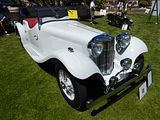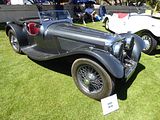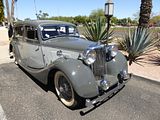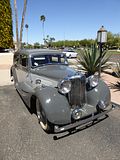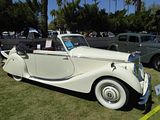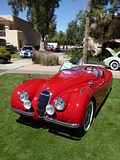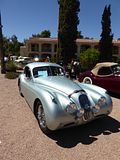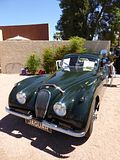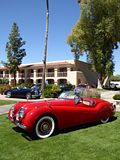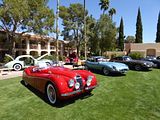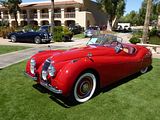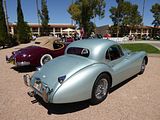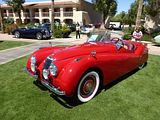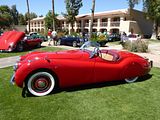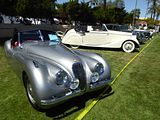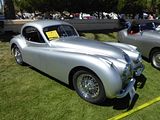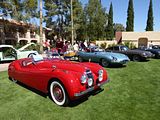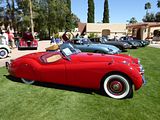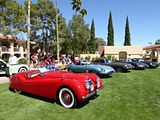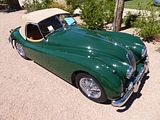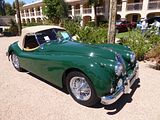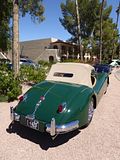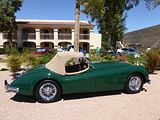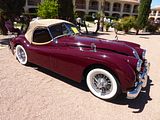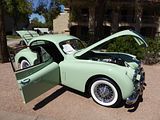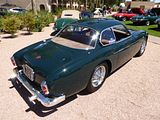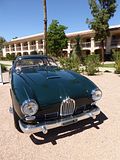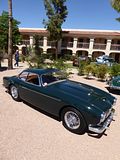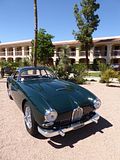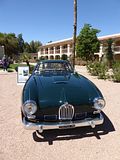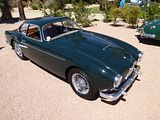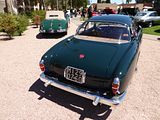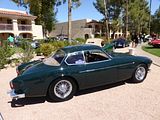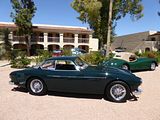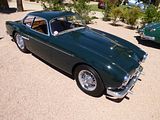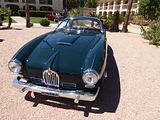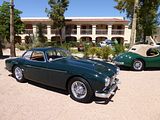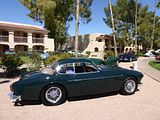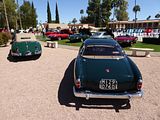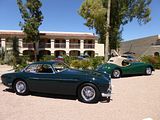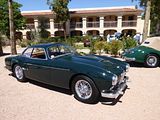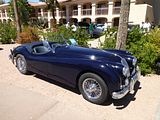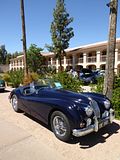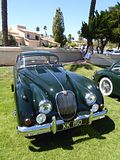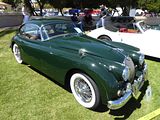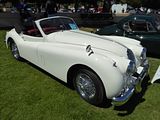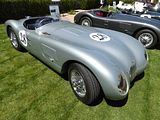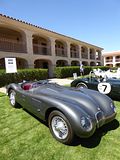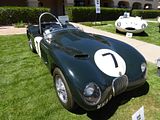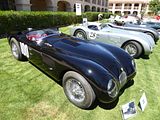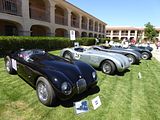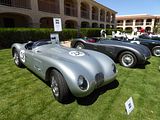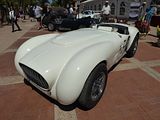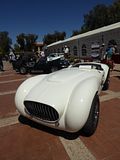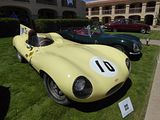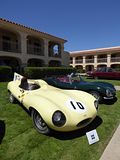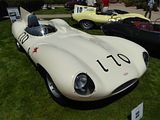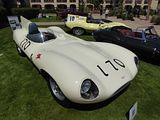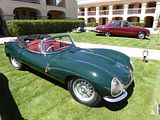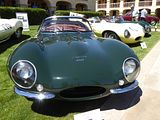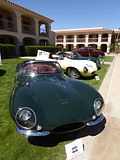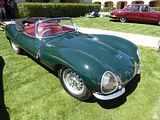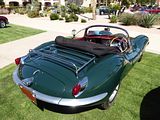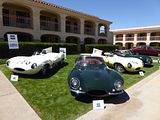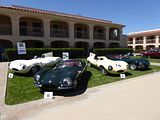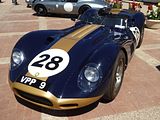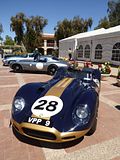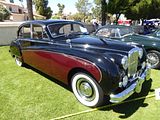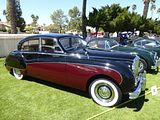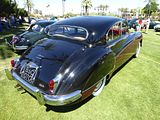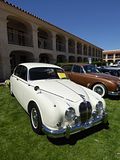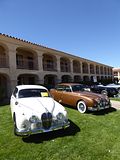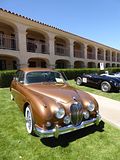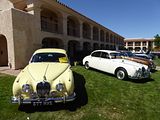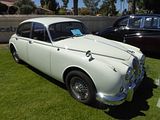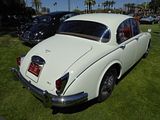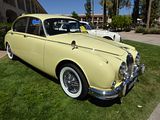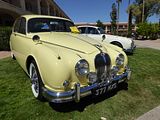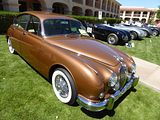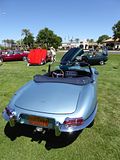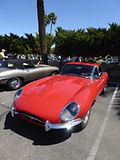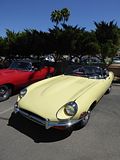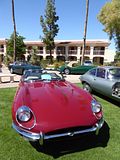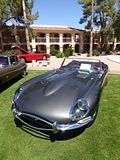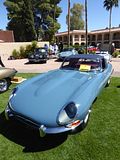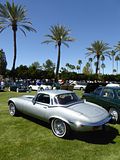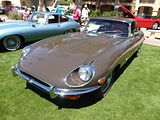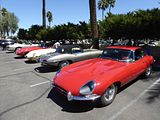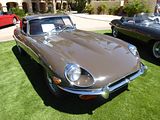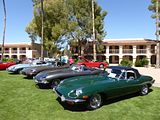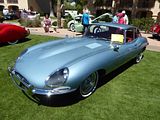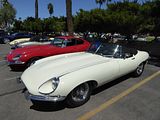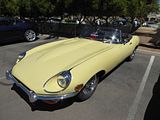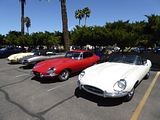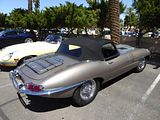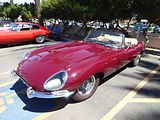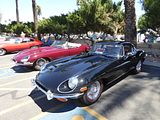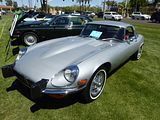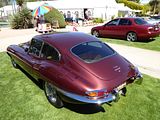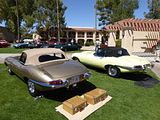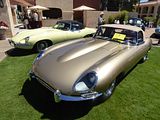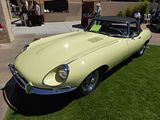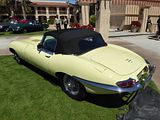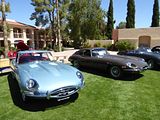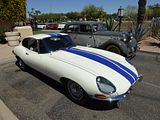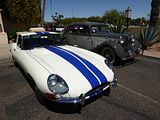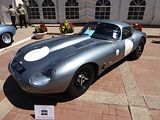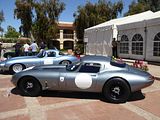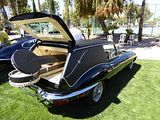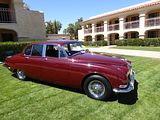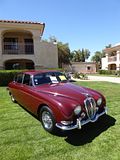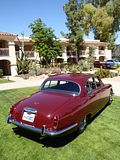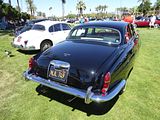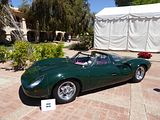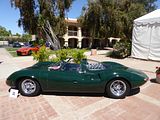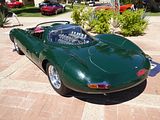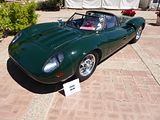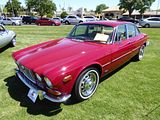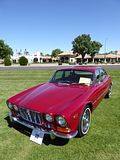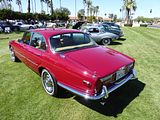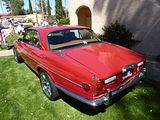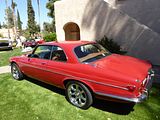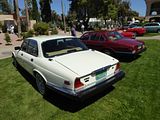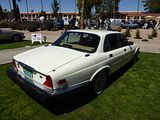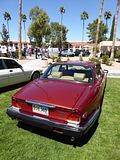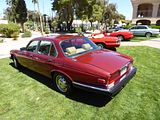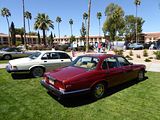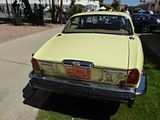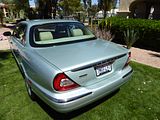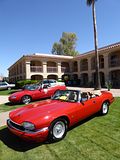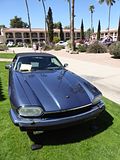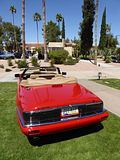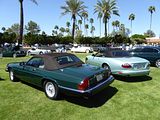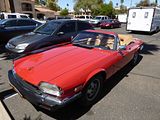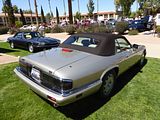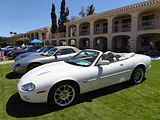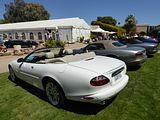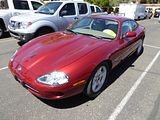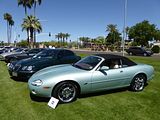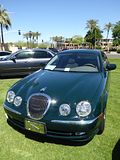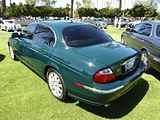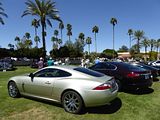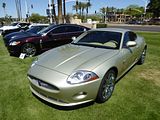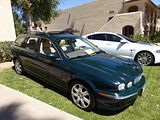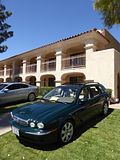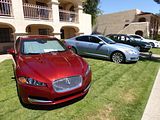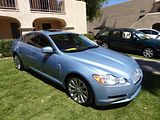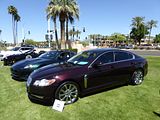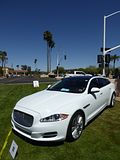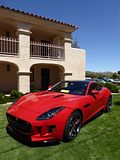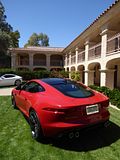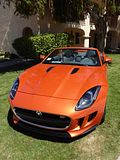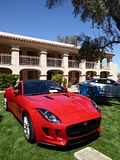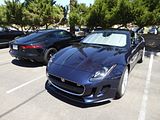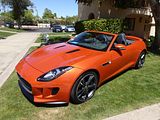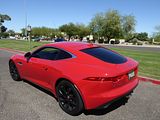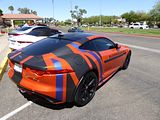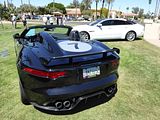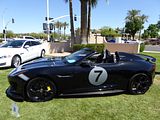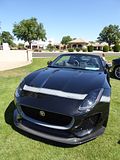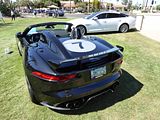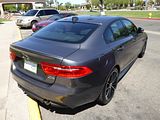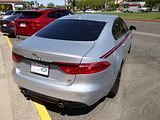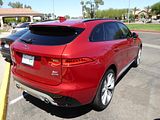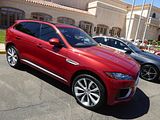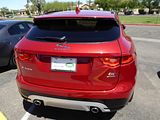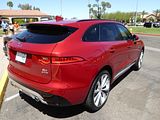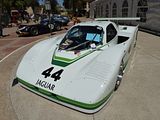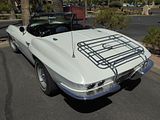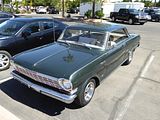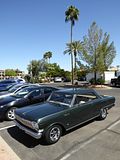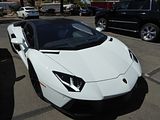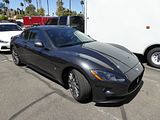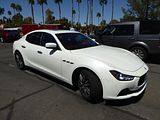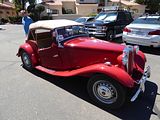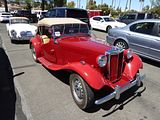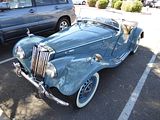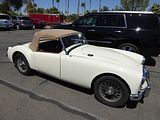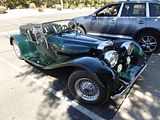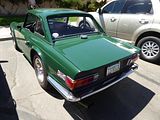Even on home soil, finding out about all the events that could be of interest to the car enthusiast is pretty difficult. Some are nationally, or internationally renowned, of course, and get lots of publicity in the months leading up to their taking place, fuelled by press releases, stories that journalists produce often based on preview of some of the proposed exhibits, as well as advertising, or careful promotion which ensures that they surface quite easily on the internet search engines. But many great events remain known only to those who are taking part, or who stumble across them by accident. If it is hard enough to find everything that is taking place locally, then the problem is compounded on foreign soil. Google, of course, is only as good as what you search for, so if you don’t put in the right word or words, you could well remain in ignorance of something really good that was just round the proverbial corner. And no matter how many search algorithms you devise, or even consolidated event listings that you find, you are simply never going to find everything. The event described here, held at the Scottsdale Plaza Resort, was taking place less than 10 miles from the hotel I was staying at for a week’s vacation in the Phoenix area. I saw no local publicity, so unless I happened to drive past it and see it going on, then I would have been completely unaware, were it not for the fact that in this case, a friend of mine who lives locally, across the other side of Phoenix drew my attention to it, He happened to be out of town for the weekend when it was taking place, but he knew I was around, and sent me the link “in case I was interested”. The event’s own website was not particularly informative, but suggested that this could be something worth investigating, and given its proximity to where I was staying, it was an easy decision to go and have a look, as it was not like I was going to be making much of a journey to find out. And I am very glad I did, as this free to visit display turned out to be like a history in lesson in Jaguar Cars.
What we are looking at here has the rather lengthy official title of the Jaguar Clubs of North America (JCNA) International Jaguar Festival and Concours 2016. Although taking place in Scottsdale, it was genuinely a National event, and I learned that it is one which is held in a different city, in a different part of America every year. Scottsdale had been chosen for the combination of availability of a suitable venue where the cars could be both displayed and indeed stored safely, as well as its climate. That there are a lot of owners of classic cars in Arizona (more per head than any other State in the USA), and that the neighbouring State of California also has an awful lot of owners must also have been a consideration. That said, there were a surprising number of cars which had travelled very long distances, in some cases, thousands of miles to be there. Although I attended on the Sunday, which was when the Concours was taking place, this was in face only part of a series of events and activities which included the JCNA AGM. Other elements of the program included a private viewing of a local collection of cars not open to the public, and various driving activities, and speakers included the current VP of Marketing for Jaguar Land Rover of North America and a former CEO of the company, as well as ex racing driver Bob Tullius, which would mean that those who had taken the time, and incurred the cost of getting there had plenty to include over the four days of the overall event.
Had I been driving down this part of the Scottsdale road, it is just possible I might have seen the cars which were displayed out front, and stopped to investigate further, as there were two elements to the Concours display. In an area facing the main road was a “Jaguar Timeline”, with one representative example of almost every different model range which has come from the marque from the 1930s up to the present day. But there was far to see that you could not see from the road. Having parked my rental Chevrolet Malibu in the main car park, and wandered through to an area which was not visible from the road, I came across a far larger collection of historic Jaguar models, generally organised by model type, and found judges in white coats with large clip boards wandering around and scrutinising the cars for everything from condition and presentation to provenance and other criteria. There was a live commentary, which of course amused me, as he even referred – not knowing that there was at least one Brit now present – to the fact that the Americans cannot get their tongues around the British pronunciation of the marque. And owner after owner who came on stage to talk briefly about their car certainly proved that! Here then, assembled in largely choronological order are the cars which were on display.
SS90
The first cars were closely related to the Austin Seven, but it was not long before Sir William Lyons was producing cars to his own design. The first of the open two-seater sports cars came in March 1935 with the SS 90, so called because of its claimed 90 mph top speed. This car used the 2½-litre side-valve, six-cylinder engine in a short-chassis “cut and shut” SS 1 brought down to an SS 2’s wheelbase. Just 23 were made.
SS100
The SS90 was the precursor to one of the finest pre-war sports car ever made, the SS100. That car benefitted from some significant engine development work that was led by Harry Westlake, who was asked to redesign the 2½-litre 70 bhp side-valve engine to achieve 90 bhp. His answer was an overhead-valve design that produced 102 bhp and it was this engine that launched the new SS Jaguar sports and saloon cars in 1936. Shown first in the SS Jaguar 2½-litre saloon, the new car caused a sensation when it was launched at a trade luncheon for dealers and press at London’s Mayfair Hotel on 21 September 1935. The show car was in fact a prototype. Luncheon guests were asked to write down the UK price for which they thought the car would be sold and the average of their answers was £765. Even in that deflationary period, the actual price at just £395 would have been a pleasant surprise for many customers, something which characterised Jaguars for many decades to come. Whilst the new Jaguar saloon could now compete with the brand new MG SA, it was the next application of the engine that stunned everyone even more, with the launch of the legendary SS100. Named because it was a genuine 100 mph car, this open topped sports car looked as good as it was to drive. Only 198 of the 2½-litre and 116 of the 3½-litre models were made and survivors are highly prized and priced on the rare occasions when they come on the market. Such is their desirability that a number of replica models have been made over the years, with those made by Suffolk Engineering being perhaps the best known, and which are indeed hard to tell apart from an original 1930s car at a glance.
MARK IV
We know this model now as the Mark IV, though this is a label which was applied retrospectively, to distinguish the cars from their successor, the Mark V. When new, the cars were sold as the Jaguar 1½ litre, Jaguar 2½ litre and Jaguar 3½ litre. Sold between 1945 and 1949, the range was a return to production of the SS Jaguar 1½ litre, 2½ litre and 3½ litre models produced by SS Cars from 1935 to 1940. SS clearly had connotations which the Coventry firm wished to avoid, hence in March 1945, the company name was changed to Jaguar Cars Ltd, and the SS moniker disappeared. All the Mark IVs were built on a separate chassis frame with suspension by semi-elliptic leaf springs on rigid axles front and rear. Biggest seller, with 10,980 examples made if you add the pre- and post war totals together, was the smallest engined model of the range, called 1½ litre. It originally featured a 1608 cc side valve Standard engine which from 1938 was replaced by a 1776 cc overhead-valve unit still from Standard who also supplied the four-speed manual transmission. Pre-war the car was available as a saloon or drophead coupé but post war only the closed model was made. Up to 1938 body construction on all the models was by the traditional steel on wood method but in that year it changed to all steel. Performance was not a strong point but 70 mph was possible: the car featured the same cabin dimensions and well-appointed interior as its longer-engined brothers. Despite its lack of out-and-out performance, a report of the time, comparing the 4-cylinder 1½-litre with its 6-cylinder siblings, opined that the smallest-engined version of the car was “as is often the case … the sweetest running car” with a “big car cruising gait in the sixties”. 6281 examples of the 2½ Litre were made. Again the engine was sourced from Standard but had the cylinder head reworked by SS to give 105 bhp. Unlike the 1½ Litre there were some drophead models made post-war. The chassis was originally of 119 in but grew by an inch in 1938 to 120 in. The extra length over the 1½ Litre was used for the six-cylinder engine as the passenger accommodation was the same size. The 3½ Litre, introduced in 1938, was essentially the same body and chassis as the 2½ Litre but its larger 125 bhp engine gave better performance but at the expense of economy. The rear axle ratio was 4.25:1 as opposed to the 4.5:1 on the 2½ Litre. 3621 of these were made. The car seen here dates from 1947 and is a 1½ Litre.
MARK V
This is a Mark V 3.5 litre Drophead Coupe. The origin of the Mark V name is somewhat mysterious as there had been no Mk I to IV Jaguars and the MK IV designation was only given to its predecessor after the launch of the Mk V. It was perhaps a nod to Bentley who built 11 advanced Mark V saloons in 1939, resuming with the Mark VI in 1946-52 and who then dropped the “Mark” naming thereafter, while Jaguars continued with the Mark VII to X. The Mark V was launched at the 1948 London Motor Show at the same time as the XK120, with which it shared a stand. However, the Mark V vastly outsold the XK120 by roughly 5,000 cars per year as compared to 2,000 per year for the XK120. While the XK120 had a new overhead-camshaft XK engine, the Mark V retained the 1936 driveline including the “Jaguar” overhead-valve pushrod straight-6, 2½ litre and 3½ litre units for which the company was renamed after the war. No 1½ litre version was offered. Claimed power output in this application was 104 bhp for the 2664 cc Mark V and 126 bhp for its more popular 3486 cc sibling. The chassis was new with independent front suspension by double wishbones and torsion bar, an arrangement that would be used by Jaguar for many future vehicles. It also had hydraulic brakes, which Jaguar had been slow to adopt compared to other manufacturers, and an all pressed steel body. The styling of the car followed prewar SS-Jaguar lines with upright chrome grille and the leaping Jaguar radiator cap mascot became available as an option. There is a distinct hint of the recently modernised Bentley look in the style of the front grille. The wheels were 16-inch steel-disc type, significantly smaller than the 18-inch ones on the MK IV. From the side, a distinctive styling touch was a “tuck in” curve at the base of the rear window following the curved profile of the side glass. Rear-wheel spats (fender skirts) were standard. Production ran through to 1951, and although the majority of Mark Vs were Saloon models, around 1000 Drophead Coupés were made as well, and these are now highly sought after.
XK120
First of the series of XK Jaguar sports car was the XK120. Launched in open two-seater form at the 1948 London Motor Show, the car was a testbed and show car for the new Jaguar XK engine. The display car was the first prototype, chassis number 670001. It looked almost identical to the production cars except that the straight outer pillars of its windscreen would be curved on the production version. The roadster caused a sensation, which persuaded Jaguar founder and design boss William Lyons to put it into production. Beginning in 1948, the first 242 cars wore wood-framed open 2-seater bodies with aluminium panels. Production switched to the 112 lb heavier all-steel in early 1950. The “120” in the name referred to the aluminium car’s 120 mph top speed, which was faster with the windscreen removed. This made it the world’s fastest production car at the time of its launch. Indeed, on 30 May 1949, on the empty Ostend-Jabbeke motorway in Belgium, a prototype XK120 timed by the officials of the Royal Automobile Club of Belgium achieved an average of runs in opposing directions of 132.6 mph with the windscreen replaced by just one small aeroscreen and a catalogued alternative top gear ratio, and 135 mph with a passenger-side tonneau cover in place. In 1950 and 1951, at a banked oval track in France, XK120 roadsters averaged over 100 mph for 24 hours and over 130 mph for an hour, and in 1952 a fixed-head coupé took numerous world records for speed and distance when it averaged 100 mph for a week. Roadsters were also successful in racing and rallying. The first production roadster, chassis number 670003, was delivered to Clark Gable in 1949. The XK120 was ultimately available in two open versions, first as an open 2-seater described in the US market as the roadster (and designated OTS, for open two-seater, in America), and from 1953 as a drophead coupé (DHC); as well as a closed, or fixed head coupé (FHC) from 1951. A smaller-engined version with 2-litres and 4 cylinders, intended for the UK market, was cancelled prior to production.
XK140
The XK140 was the successor to the XK120, with a number of useful changes and upgrades over the earlier car which included more interior space, improved brakes, rack and pinion steering, increased suspension travel, and telescopic shock absorbers instead of the older lever arm design. The XK140 was introduced in late 1954 and sold as a 1955 model. Exterior changes that distinguished it from the XK120 included more substantial front and rear bumpers with overriders, and flashing turn signals (operated by a switch on the dash) above the front bumper. The grille remained the same size but became a one-piece cast unit with fewer, and broader, vertical bar, making it easy to tell an XK140 apart from an XK120. The Jaguar badge was incorporated into the grille surround. A chrome trim strip ran along the centre of the bonnet and boot lid. An emblem on the boot lid contained the words “Winner Le Mans 1951–3”. The interior was made more comfortable for taller drivers by moving the engine, firewall and dash forward to give 3 inches more legroom. Two 6-volt batteries, one in each front wing were fitted to the Fixed Head Coupe, but Drop Heads and the Open Two Seater had a single 12-volt battery. This was installed in the front wing on the passenger side (e.g. In the left wing on right hand drive cars and in the right wing on left hand drive). The XK140 was powered by the Jaguar XK engine with the Special Equipment modifications from the XK120, which raised the specified power by 10 bhp to 190 bhp gross at 5500 rpm, as standard. The C-Type cylinder head, carried over from the XK120 catalogue, and producing 210 bhp ross at 5750 rpm, was optional equipment. When fitted with the C-type head, 2-inch sand-cast H8 carburettors, heavier torsion bars and twin exhaust pipes, the car was designated XK140 SE in the UK and XK140 MC in North America. In 1956 the XK140 became the first Jaguar sports car to be offered with automatic transmission. As with the XK120, wire wheels and dual exhausts were options, and most XK140s imported into the United States had wire wheels. Cars with the standard disc wheels had spats (fender skirts) over the rear wheel opening. When leaving the factory it originally fitted either 6.00 × 16 inch crossply tyres or you could specify 185VR16 Pirelli Cinturato CA67 as a radial option on either 16 × 5K½ solid wheels or 16 × 5K (special equipment) wire wheels. The Roadster (designated OTS – Open Two Seater – in America) had a light canvas top that folded out of sight behind the seats. The interior was trimmed in leather and leatherette, including the dash. Like the XK120 Roadster, the XK140 version had removable canvas and plastic side curtains on light alloy barchetta-type doors, and a tonneau cover. The door tops and scuttle panel were cut back by two inches compared to the XK120, to allow a more modern positioning of the steering wheel. The angle of the front face of the doors (A-Post) was changed from 45 degrees to 90 degrees, to make access easier. The Drophead Coupé (DHC) had a bulkier lined canvas top that lowered onto the body behind the seats, a fixed windscreen integral with the body (the Roadster’s screen was removable), wind-up side windows, and a small rear seat. It also had a walnut-veneered dashboard and door cappings. The Fixed Head Coupé (FHC) shared the DHC’s interior trim and rear seat. The prototype Fixed Head Coupe retained the XK120 Fixed Head roof-profile, with the front wings and doors the same as the Drophead. In production, the roof was lengthened with the screen being placed further forward, shorter front wings, and longer doors. This resulted in more interior space, and more legroom. The XK140 was replaced by the XK150 in March 1957.
One of the nicest of the XK140s on show was this SE model which was originally built for King Hussein of Jordan.
Definitely one of the stars of the day was this 1957 XK140 Zagato, a one-off car. It came about as soon after buying a brand-new Jaguar XK140, businessman Guido Modiano – whose company specialised in printing playing cards – called upon Zagato to create a one-off body after the standard car had sustained crash damage. Before then, Zagato had largely specialised in attaching light, aerodynamic bodies to brand-new chassis with competition exploits in mind. But when Modiano approached Elio Zagato – who had recently graduated with an Economics degree – the eldest Zagato son saw the chance for the Milanese company to conjour up new business by coachbuilding bespoke road cars. So proud was Elio with the heightened level of finish, he asked to show the resulting XK140 re-working at the 1957 Paris Motor Show, from which a positive response led to a production run being investigated, though that did not happen. Just 2 further examples were built, both based on the later XK150 chassis. Although bearing some similarities to Alfa Romeos of the time, this Jaguar perhaps more closely resembles Zagato’s take on the Ferrari 250 GT – unsurprising, considering they quite possibly would have shared space in the carrozzeria’s Milanese workshop. The double-bubble roof is notably absent, although the concept of the light, airy panoramica roof was still very much in vogue. Additional freedom afforded by the non-racing intentions of the car led to such delights as tan suede on almost every interior surface, and even little ‘J’ emblems in the headlights – both completely unnecessary, but wonderful nonetheless. Quite simply, elegance took precedence. That’s not to say Zagato’s revisions were ultimately anything other than beneficial, however. Not only was the bodywork much more contemporary in appearance, it was also lighter, reaping obvious dynamic advantages. The thinner aluminium panels also act as an amphitheatre for the glorious noise emitted from the pipes of the lightly tuned 3.4-litre straight-six. During restoration in the early 2000s, traces of chassis damage from the original crash were found. However, since they were proved not to impair structural integrity, its then-owner insisted they remain untouched as part of the car’s unique story. Since then, the car has spent more than a decade being shown at numerous concours events, including the 2014 Concours of Elegance at Hampton, though it does still live in Arizona, so this made it a local car.
XK150
Although bearing a family resemblance to the earlier XK120 and XK140, the XK150, launched in the spring of 1957, was radically revised. A one-piece windscreen replaced the split screen, and the wing line no longer dropped so deeply at the doors. The widened bonnet opened down to the wings, and on the Roadster the windscreen frame was moved back 4 inches to make the bonnet longer. The XK140’s walnut dashboard was replaced by one trimmed in leather. On the early Drophead Coupés, the aluminium centre dash panel, which was discontinued after June 1958, had an X pattern engraving similar to the early 3.8 E-Type. Thinner doors gave more interior space. On the front parking lights, which were located atop the wings, a little red light reminded the driver the lights were on. Suspension and chassis were very similar to the XK140, and steering was by rack and pinion; power steering was not offered. The standard engine, the similar to the XK140, but with an new “B” type cylinder head, was the 3.4 litre DOHC Jaguar straight-6 rated at 180 SAE bhp at 5750 rpm but most cars were fitted with the SE engine whose modified cylinder head (B type) and larger exhaust valves boosted the power to 210 SAE bhp at 5500 rpm. Twin 1.75-inch (44 mm) SU HD6 carburettors were fitted. While the first XK150s were slower than their predecessors, the deficit was corrected in the spring of 1958 with a 3.4-litre “S” engine whose three 2-inch SU HD8 carburettors and straight-port cylinder head increased power to a claimed 250 SAE bhp. For 1960, the 3.4 litre engine was bored to 3.8 litres, rating this option at 220 hp in standard tune or 265 hp in “S” form. A 3.8 litre 150S could top 135 mph and go from 0–60 mph in around 7.0 seconds. Fuel economy was 18mpg. Four-wheel Dunlop 12 in disc brakes appeared for the first time although it was theoretically possible to order a car with drums. When leaving the factory the car originally fitted either 6.00 × 16 inch Dunlop Road Speed tyres as standard, or you could specify 185VR16 Pirelli Cinturato CA67 as a radial option on either 16 × 5K½ solid wheels (basic models) or 16 × 5K wire wheels. Production ended in October 1960, and totalled 2265 Roadsters, 4445 Fixed Head Coupés and 2672 Drophead Coupés.
C TYPE
The C-Type was built specifically for the race track . It used the running gear of the contemporary road-proven XK120 clothed in a lightweight tubular frame, devised by William Heynes, and clothed in an aerodynamic aluminium body designed by Malcolm Sayer. The road-going XK120’s 3.4-litre twin-cam, straight-6 engine produced between 160 and 180 bhp, but when installed in the C-Type, it was originally tuned to around 205 bhp. Early C-Types were fitted with SU carburettors and drum brakes. Later C-Types, from mid 1953, were more powerful, using triple twin-choke Weber carburettors and high-lift camshafts. They were also lighter, and braking performance was improved with disc brakes on all four wheels, which were something of a novelty at the time, though their adoption started to spread quite quickly after Jaguar had used them. The lightweight, multi-tubular, triangulated frame was designed by William Heynes. Malcolm Sayer designed the aerodynamic body. Made of aluminium in the barchetta style, it is devoid of road-going items such as carpets, weather equipment and exterior door handles. The C-Type was successful in racing, most notably at the Le Mans 24 hours race, which it won twice. In 1951 the car won at its first attempt. The factory entered three, whose driver pairings were Stirling Moss and Jack Fairman, Leslie Johnson and triple Mille Miglia winner Clemente Biondetti, and the eventual winners, Peter Walker and Peter Whitehead. The Walker-Whitehead car was the only factory entry to finish, the other two retiring with lack of oil pressure. A privately entered XK120, owned by Robert Lawrie, co-driven by Ivan Waller, also completed the race, finishing 11th. In 1952 Jaguar, worried by a report about the speed of the Mercedes-Benz 300SLs that would run at Le Mans, modified the C-Type’s aerodynamics to increase the top speed. However, the consequent rearrangement of the cooling system made the cars vulnerable to overheating, and all three retired from the race. The Peter Whitehead-Ian Stewart and Tony Rolt/Duncan Hamilton cars blew head gaskets, and the Stirling Moss-Peter Walker car, the only one not overheating having had a full-sized radiator hurriedly fitted, lost oil pressure after a mechanical breakage. Testing by Norman Dewis at MIRA after the race proved that the overheating was caused more by the revisions to the cooling system than by the altered aerodynamics: the water pump pulley was undersized, so it was spinning too fast and causing cavitation; also the header tank was in front of the passenger-side bulkhead, far from the radiator, and the tubing diameter was too small at 7/8 inch. With the pump pulley enlarged, and the tubing increased to 1 1/4 inch, the problem was eliminated. The main drawback of the new body shape was that it reduced downforce on the tail to the extent that it caused lift and directional instability at speeds over 120 mph on the Mulsanne Straight. These cars had chassis numbers XKC 001, 002 and 011. The first two were dismantled at the factory, and the third survives in normal C-type form. In 1953 C-Types won again, and also placed second and fourth. This time the body was in thinner, lighter aluminium and the original twin H8 sand cast SU carburettors were replaced by three DCO3 40mm Webers, which helped boost power to 220 bhp. Further weight was saved by using a rubber bag fuel tank, lighter electrical equipment and thinner gauge steel for some of the chassis tubes . Duncan Hamilton and Tony Rolt won the race at 105.85 mph (170.35 km/h) – the first time Le Mans had been won at an average of over 100 miles per hour (161 km/h). 1954, the C-Type’s final year at Le Mans, saw a fourth place by the Ecurie Francorchamps entry driven by Roger Laurent and Jacques Swaters. Between 19951 and 1953, a total of 53 C-Types were built, 43 of which were sold to private owners mainly in the US. When new, the car sold for about $6,000, approximately twice the price of an XK120. Genuine cars have increased in value massively in recent years, however buyers do need to be aware that replicas have been produced by a number of companies, though even these are far from cheap to buy thesedays. Cars with true racing provenance are well into the millions now. A C-Type once owned and raced by Phil Hill sold at an American auction in August 2009 for $2,530,000 and another C-type was sold at the Pebble Beach auction in 2012 for $3,725,000, More recently an unrestored C-Type that raced at Le Mans has sold for £5,715,580, during the Grand Prix Historique race meeting in Monaco. In August 2015, an ex-Ecurie Ecosse Lightweight C-type, chassis XKC052 and the second of only three works lightweights, driven by Peter Whitehead and Ian Stewart to fourth at the 1953 Le Mans 24 Hours, fetched £8.4 million at auction in California.
HANGSEN JAGUAR
Walter E. Hansgen, a sports car legend from the 1950s, campaigned a new Jaguar XK120 in 1951, and he soon realised he would need a new C-Type to compete against Allards and Ferraris. But the factory didn’t make the cars available to newcomers, so Hansgen built his own racer, tearing into his year-old XK120 for components. A frame was hand-fabricated from chrome-moly tubing. To locate the rear axle, Hansgen added trailing arms and replaced the rear springs with coil-overs. An MG-TD steering rack was added. The breathed-on Jaguar 3.4-litre engine, transmission and front suspension were mounted in the new frame to pickup points welded in from Hansgen’s donor car. The car’s hand-hammered aluminum body is striking, with hints of C-Type, Ferrari and Healey Silverstone. Among the distinguishing features are the recessed and exposed rear spare, the faired-in headlight area and the driver’s side exhaust. The engine compartment is simple and antiseptic, all polished metal. There are twin filler caps the aircraft wing tank, now lined with a cell. Brakes are drilled XK120 drums, lined in carbon-Kevlar. A removable roll bar was added. Hansgen campaigned the car successfully in 1953, winning at such events as the Watkins Glen Grand Prix. Hansgen died soon after a crash in 1966 in a Ford GT. The car then changed hands several times, and current owner, Millstein, first saw it at Mount Equinox in 1979. Millstein bought the car in 1983, then restored it. Millstein rebuilt and blueprinted the engine, adding stainless steel headers. Dual 1.75-inch SU carbs feed the intake manifold. With forged pistons, Iskenderian racing cam and a competition valve grind, Millstein estimates output at 275 hp for the 2100-pound car. The car is still used competitively.
D TYPE
Successor to the C Type was the D Type. Although it shared many of its mechanical components with the C-Type, including the basic straight-6 XK engine design, initially of 3.4 litres and later enlarged to 3.8 litres in the late fifties, the structure of the car was radically different. The innovative monocoque construction brought aviation industry technology to competition car design, together with an aeronautical understanding of aerodynamic efficiency. The structural design, revolutionary at the time, applied aeronautical technology. The “tub”, or cockpit section, was of monocoque construction, mostly comprising sheets of aluminium alloy. Its elliptical shape and comparatively small cross-section provided torsional rigidity and reduced drag. To the front bulkhead was attached an aluminium tubing subframe for the engine, steering assembly, and front suspension. Rear suspension and final drive were mounted to the rear bulkhead. Fuel was carried in the tail and the designers followed aviation practice by specifying a deformable Marston Aviation Division bag in place of a conventional tank. The aerodynamic bodywork was largely the work of Malcolm Sayer, who had joined Jaguar following a stint with the Bristol Aeroplane Company during the Second World War and later worked on the C-Type. For the D-Type, he insisted on a minimal frontal area. To reduce the XK engine’s height, Jaguar’s chief engineer, William Haynes, and former Bentley engineer, Walter Hassan, developed dry sump lubrication, and it has been said that the car’s frontal area was also a consideration in canting the engine at 8½° from the vertical (which necessitated the offset bonnet bulge). Philip Porter, in his book Jaguar Sports Racing Cars, says that “[a] more likely reason was to provide extra space for the ram pipes feeding the three twin-choke Weber carburettors.” Reducing underbody drag contributed to the car’s high top speed; for the long Mulsanne Straight at Le Mans, a fin was mounted behind the driver for aerodynamic stability. For the 1955 season, factory cars were fitted with a longer nose, which lengthened the car by 7½ inches and further increased maximum speed; and the headrest fairing and aerodynamic fin were combined as a single unit that smoothed the aerodynamics and saved weight. Mechanically, many features were shared with the outgoing C-Type. Its front and rear suspension and innovative all-round disc brakes were retained, as was the XK engine. Apart from the new lubrication system, the engine was further revised as development progressed during the D-Type’s competition life. Notably in 1955 larger valves were introduced, together with asymmetrical cylinder heads to accommodate them. Jaguar D-Types fielded by a team under the leadership of Jaguar’s racing manager Lofty England were expected to perform well in their debut at the 1954 24 Hours of Le Mans race. In the event, the cars were hampered by fuel starvation caused by problems with the fuel filters, necessitating pit stops for their removal, after which the entry driven by Duncan Hamilton and Tony Rolt speeded up to finish less than a lap behind the winning Ferrari. The D-Type’s aerodynamic superiority is evident from its maximum speed of 172.8 mph on the Mulsanne Straight compared with the 4.9 litre Ferrari’s 160.1 mph. For 1955 the cars were modified with long-nose bodywork and engines uprated with larger valves. At Le Mans, they proved competitive with the Mercedes-Benz 300 SLRs, which had been expected to win. Mike Hawthorn’s D-Type had a narrow lead over Juan Manuel Fangio’s Mercedes when another Mercedes team car was involved in the most catastrophic accident in motorsport history.Driver Pierre Levegh and more than 80 spectators lost their lives, while many more were injured. Mercedes withdrew from the race. Jaguar opted to continue, and the D-Type driven by Hawthorn and Ivor Bueb went on to win. Mercedes withdrew from motorsport at the end of the 1955 season, and Jaguar again entered Le Mans in 1956. Although only one of the three factory-entered cars finished, in sixth place, the race was won by a D-Type entered by the small Edinburgh-based team Ecurie Ecosse and driven by Ron Flockhart and Ninian Sanderson, beating works teams from Aston Martin and Scuderia Ferrari. In America, the Cunningham team raced several D-Types. In 1955, for example, a 1954 works car on loan to Cunningham won the Sebring 12 Hours in the hands of Mike Hawthorn and Phil Walters, and in May 1956 the team’s entries for Maryland’s Cumberland national championship sports car race included four D-Types in Cunningham’s white and blue racing colors. Driven by John Fitch, John Gordon Benett, Sherwood Johnston and team owner Briggs Cunningham, they finished fourth, fifth, seventh and eighth, respectively. Although Jaguar withdrew from motorsport at the end of the 1956 season, 1957 proved to be the D-Type’s most successful year. Jaguar D-Types took five of the top six places at Le Mans; Ecurie Ecosse, with considerable support from Jaguar, and a 3.8-litre engine, again took the win, and also second place. This was the best result in the D-Type’s racing history. Rules for the 1958 Le Mans race limited engine sizes to three litres for sports racing cars, which ended the domination of the D-Type with its 3.8-litre XK engine. Jaguar developed a three-litre version to power D-Types in the 1958, 1959 and 1960 Le Mans races but it was unreliable, and by 1960 it no longer produced sufficient power to be competitive. The D-Type’s success waned as support from Jaguar decreased and the cars from rival manufacturers became more competitive. Although it continued to be one of the cars to beat in club racing and national events, the D-Type never again achieved a podium finish at Le Mans. By the early 1960s it was obsolete. Total D-Type production is thought to have included 18 factory team cars, 53 customer cars, and 16 XKSS versions. A 1955 car was sold at Sothebys in 2016 for £19,8 million, making it the most valuable British car ever.
XKSS
Following Jaguar’s withdrawal from competition at the end of the 1956 season, a number of completed and partly completed D Types remained unsold at the Browns Lane factory. In an attempt to recoup some of the investment made in building these unused chassis, and to exploit the lucrative American market for high-performance European sports cars, Sir William Lyons decided to convert a number to road-going specification. Only minor changes were made to the basic D-type structure: the addition of a passenger side door; the removal of the large fin behind the driver; and the removal of the divider between passenger and driver seats. In addition, changes were made for cosmetic, comfort and legal reasons: a full-width, chrome-surrounded windscreen was added; sidescreens were added to both driver and passenger doors; a rudimentary, folding, fabric roof was added for weather protection; chromed bumpers were added front and rear (a styling cue later used on the E-type); XK140 rear light clusters were mounted higher on the wings; and thin chrome strips were added to the edges of the front light fairings. On the evening of 12 February 1957, a fire broke out at the Browns Lane plant destroying nine of the twenty-five cars that had already been completed or were semi-completed. Most of the surviving 16 XKSSs were sold in the USA. Many replica versions have subsequently been built. In March 2016, Jaguar announced that it would be completing the original 25 car order from 1957 by building from scratch the remaining 9 cars destroyed by the plant fire. The cars are expected to sell for more than £1 million
LISTER
Also seen here was an example of the Lister-Jaguar, which ended up as Britain’s most successful sports racing car of the 1950’s. It won at almost every circuit in Britain and was virtually unbeatable both in the UK, overseas and in the USA and continued to keep the Jaguar name in the forefront of sports car racing long after the Jaguar D Type had become obsolete. The ‘Cars from Cambridge’ designed, and built by Brian Lister, were simply the best of their kind and dominated the field with Archie Scott Brown driving, even when driven by Stirling Moss, who also drove a stint for Lister. Brian Lister’s big break came when he was offered the engines and gearboxes by William Lyons from the retiring Jaguar D Types which had previously dominated at Le Mans, but which by 1956 were fast becoming outdated. Lyons was correct in believing that Lister would be capable of developing a race winning car, thus keeping the Jaguar name in the forefront of racing and at little cost to Jaguar and so Lister-Jaguar was born. Brian Lister designed and built a new lightweight and aerodynamic chassis and ‘knobbly’ body to take the Jaguar drive train and the world’s best sport racing car of the 1950’s was born! For five seasons from 1954 Lister cars were always in the headlines and consistently beat the much larger works teams such as Aston Martin and Jaguar. It caught the public’s imagination, especially popular was the mercurial and respected Archie Scott Brown, he was fiercely competitive, fun to be with, adored by everyone with film star looks even though he was severely disabled from birth. Unfortunately, in 1958 Archie Scott Brown died after suffering severe burns in a racing car accident at Spa. The car was criticised for having magnesium alloy bodywork which was inflammable, although an RAC examination found no faults with the car. Brian Lister persevered for a few years afterwards, but without his friend Archie things were just never quite the same. It was left to Laurence Pearce in 1995 to take up the charge, Pearce designed a new series of Lister Storm GT race cars and spent the next decade rebuilding the racing heritage the ‘glory days’ were back with winning drivers such as Tiff Needell. And then in September 2013, an exciting announcement came. that after a gap of almost 25 years since the last Lister had rolled off the production line, the three Lister companies of Lister Jaguar, Brian Lister Light Engineering and Lister Storm, had been reunited into one organisation, called Lister Motor Company Limited, after a significant investment by Warrantywise, one of the UK’s most successful aftermarket used car warranty providers, to herald the return of one of the Lister ‘Knobbly’ Jaguar. The plans called for the production of 10 of what was once of the most exiting British sports/racing GTs. Lister Motor Company Limited had invested in a new, a state-of-the-art facility in Cambridge, including CNC machining, 3D scanning and Catia design, all of which would enable George Lister Engineering to develop and deliver an exciting and near identical development of the historic, race-winning, competition and track car. Brian Lister’s original working drawings and manufacturing jigs were all re-commissioned, and many of the team involved in the original 1950’s project with Lister Cars were called back into service, including Martin Murray, Colin (Chippy) Crisp, Graham (Curley) Hutton, Laurence Pearce and even Brian Lister himself. Heading up the manufacturing project was Mark Hallam, technical director at George Lister Engineering. The cars were planned to be identical to those of 1958, out of the box and ready to race with BHL-C (C for Continuation) chassis insignia and up to FIA/HTP Appendix K specification. Race proven, Jaguar D Type-specification engines and D Type gearboxes were to be supplied by world-renowned experts, Crosthwaite & Gardiner, and all race preparation and track commissioning would be undertaken by Chris Keith-Lucas of CKL Developments, another leading specialist in historic Jaguar restoration and preparation. Last but not least, that fantastic streamlined Knobbly body was to be re-created, using the original jigs. The first car was seen in 2014, and production has continued at a very gradual rate ever since.
MARK IX
Jaguar launched the Mark IX in 1959, as a replacement for the previous Mark VIII. The early versions were identical in exterior appearance to the Mark VIII except for the addition of a chrome “Mk IX” badge to the boot lid. Later versions had a larger tail-lamp assembly with the addition of an amber section for traffic indication, visually similar to the tail-lights of the smaller Mark 2 Jaguar sedan. By the time the Mark IX reached the market, it was quite an old design, as it was based on the Mark VII which had been first seen in 1950. The Mark VII chassis came from the even earlier Jaguar Mark V but whilst the wheelbase remained the same at 10 feet, the new model’s body looked more streamlined, with integrated headlights and mudguards, a two-piece windscreen, and longer rear overhang. As on the Mark V, the rear wheels were partially covered by removable spats. Whereas the Mark V had a prewar engine originally developed by the Standard Motor Company, the Mark VII was powered by the newly developed XK engine, which had first been seen in the 1948 XK120, with the 3442 cc straight-six providing 160 bhp, the same as in the XK120. Published performance figures for the Mark VII were based on the standard 8:1 compression ratio, but as this was unsuitable for the UK market’s low-octane Pool petrol, an engine with a lower compression ratio of 7:1 engine was optional. British motoring magazines tested the car’s performance with the higher compression ratio, using the Ostend to Brussels autoroute in Belgium, where 80 octane fuel was available. In 1952, The Motor recorded a top speed of 101 mph, 0–60 mph in 13.7 seconds and returned 17.6 miles per imperial gallon. These were impressive figures for the time, and were one reason why the car was popular in motorsport as well as on the road. When the car was being developed Jaguar thought it would find most of its customers overseas, mainly because UK car tax at that time penalised buyers of larger-engined cars. However it went into production just as Britain’s postwar economic austerity began to ease, and in 1951 the car’s enthusiastic reception in both the British and American markets prompted Jaguar to relocate production to larger premises, at the Browns Lane plant, which had been built for wartime production as a shadow factory and was now available for immediate use. By the time the Mark VII was upgraded to M specification in 1954, 20,908 had been produced. Launched at the London Motor Show in October 1954, the Mark VII M continued with the same capacity and 8:1 compression ratio, uprated to 190 bhp. A four-speed manual gearbox was standard, while the Borg Warner automatic, introduced in 1953 and hitherto available only on exported Mark VIIs, now became optional for British buyers. Distinguishing the Mark VII M from its predecessor, circular grilles over the horns were installed below the headlights in place of the former integrated auxiliary lamps, which were moved slightly further apart and mounted on the bumper. Both bumpers now wrapped further around the sides of the car. In 1956, with the advent of the Suez Crisis Britain anticipated fuel rationing, and bubble cars appeared on the streets. Jaguar switched focus to their smaller saloons (the Mark I 2.4 had been introduced in 1955), and neither the Mark VII M nor any of its increasingly powerful but fuel-thirsty successors would match the production volumes of the original Jaguar Mark VII. Nevertheless, before it was superseded by the Mark VIII, the Mark VII M achieved 10,061 sales during its two-year production run. The Mark VII was succeeded by the Mark VIII i 1956, and although this looked very similar, there were plenty of detailed differences, The interior fittings were more luxurious than those of the Mark VII. Distinguishing visually between the models is facilitated by changes to the front grille, the driving or fog lamps being moved from the front panel to the horizontal panel between bumper and front panel, larger rear lamps and most obviously a curved chrome trim strip below the waistline which allowed the factory to offer a variety of two-tone paint schemes. In addition the new car had rear spats that were cut back to display more of the rear wheels and featured a one-piece slightly curved windscreen, where the Mark VII had incorporated a two-piece front screen of flat glass. Just 6227 examples were made before the introduction of the Mark IX. The new car had a larger 3.8 litre 190 bhp version of the XK engine Standard transmission was a four-speed manual system: options included overdrive, but most cars were built with a Borg Warner three-speed automatic box. The Mark IX was the first production Jaguar to offer four-wheel servo-assisted Dunlop disc brakes and recirculating ball power steering, which were now standard equipment. The brake system included a vacuum reserve tank to preserve braking in the event that the engine stalled. On models with automatic transmission, the brakes were equipped with an electromagnetic valve that maintained brake pressure at rest when the brake pedal was released to prevent the car from rolling back on an incline, hence its name “Hill Holder”. The Hill Holder was often troublesome (failing to release the brakes when the accelerator was depressed) and was disconnected on most cars without ill effect. The power steering was driven by a Hobourn-Eaton pump, operating at 600-650 psi. It was attached to the back of the generator and allowed the steering to be geared up to 3.5 turns lock-to-lock as against the 4.5 turns for the Mark VII and VIII models. The sunshine roof became a standard fitting for the UK market. The interior was in the same luxurious mode with extensive use of leather, walnut wood trim and deep pile carpet. A range of single and duo-tone paint schemes was offered.
10,009 examples of the Mark IX were made before its replacement in 1961 by the lower and more contemporary-styled Mark X.
MARK 2
One of the most loved Jaguars of all time, both when it was new, and still now, is the Mark 2 saloon. Many will tell you that it is not the 3 Series BMW that “invented” the “compact sports saloon” car class, but this model, which dates back to 1959. A thorough revision of the small Jaguar saloon that had joined the range in 1955, the Mark 2 was notable in that it was the first car to use the Arabic numeral in its name, as opposed to the Roman numerals of the larger Jaguar models. At launch, the earlier model which had hitherto been known by its engine size was christened the Mark 1. Although clearly based on that car, the updated car looked significantly different, with an increase of 18% in cabin glass area greatly improving visibility. The car was re-engineered above the waistline. Slender front pillars allowed a wider windscreen and the rear window almost wrapped around to the enlarged side windows now with the familiar Jaguar D-shape above the back door and fully chromed frames for all the side windows. The radiator grille was amended and larger side, tail and fog lamps repositioned. Inside a new heating system was fitted and ducted to the rear compartment (although still notoriously ineffective). There was an improved instrument layout that became standard for all Jaguar cars until the XJ Series II of 1973. As well as the familiar 2.4 and 3.4 litre engines, what made this car particularly special was that it was also offered with the potent 220 bhp 3.8 litre unit that was fitted to the XK150 and which would later see service in the E Type. This gave the car a 0 – 60 time of around 8.5 seconds and a top speed of 125 mph. No wonder that the Mark 2 became popular as a get-away car for the criminal fraternity, and to keep up with and catch them, many police forces bought the car as well. With revised suspension and standard four wheel disc brakes, the car was effective on the track, taking plenty of class wins when new, and it is still popular in historic racing circles today. The quickest and most successful private entries came from John Coombs, a man with significant race experience who operated a large Jaguar dealership in Guildford. Coombs would undertake modifications to meet the demands of his customers, so not all the cars that he worked on are the same. Jaguar replaced the Mark 2 with simplified and slightly more cheaply finished 240 and 340 models, as an interim measure until an all-new model was ready to take over from them. The 3.8 litre disappeared from the range at this time, but in the 7 years it had been in production, it had been the best seller of the range, with around 30,000 cars produced, as compared to 28,666 of the 3.4 litre and 25,741 of the 2.4 litre model.
E TYPE (XK-E)
Jaguar launched 2 new models in 1961. One was the gargantuan Mark X, which replaced the elderly Mark IX at the top of the saloon car range, but it is the other one which is better remembered and loved even now, more than 50 years after stunning the world at the 1961 Geneva Show. That car, of course, is the famous E Type, considered by many to be Sir William Lyons’ greatest achievement. Not only did the car have stop-you-in-your-tracks gorgeous styling, but it had explosive performance (even if the 150 mph that was achieved in The Autocar’s Road Test is now known to have been with a little “help”), but it was the price that amazed people more than anything else. Whilst out of reach for most people, who could barely afford any new car, it was massively cheaper than contemporary Aston Martins and Ferraris, its market rivals. It was not perfect, though, and over the coming years, Jaguar made constant improvements. A 2+2 model joined the initial range of Roadster and Coupe, and more powerful and larger engines came when the 3.8 litre was enlarged to 4.2 litres, before more significant styling changes came with the 1967 Series 2 and the 1971 Series 3, where new front end treatments and lights were a consequence of legislative demands of the E Type’s most important market, America. Although many of the cars that were first sold in the US have since been repatriated, there are still plenty that live on American soil, so it was no surprise that there were more of what the Americans called the XK-E here than any other model.
Shortly after the introduction of the E-Type, Jaguar management wanted to investigate the possibility of building a car more in the spirit of the D-Type racer from which elements of the E-Type’s styling and design were derived. One car was built to test the concept designed as a coupé. Unlike the steel production E-Types, the LDC used lightweight aluminium. Malcolm Sayer retained the original tub with lighter outer panels riveted and glued to it. The front steel sub frame remained intact, the windshield was given a more pronounced slope, and the rear hatch was welded shut. Rear brake cooling ducts appeared next to the rear windows, and the interior trim was discarded, with only insulation around the transmission tunnel. With the exception of the windscreen, all cockpit glass was perspex. A tuned version of Jaguar’s 3.8-litre engine with a wide-angle cylinder head design tested on the D-Type racers was used. The only test bed car was completed in summer of 1962 but was sold a year later to Jaguar racing driver Dick Protheroe. Since then it has passed through the hands of several collectors on both sides of the Atlantic and is now believed to reside in the private collection of the current Viscount Cowdray. Peter Lindner, the Jaguar distributor in Germany, had his Lightweight modified by the factory to include the Sayer low drag roof and rear panels as part of an effort to win the GT class at LeMans. Lindner’s car was more than a match for the Ferrari 250 GTO but mechanical problems forced it out of the race. Lindner was later killed in a racing accident that demolished his car, which has recently been restored. Jaguar waited too long before committing to a racing program in earnest and what could have been a world champion in 1962 was not competitive by 1965. The next evolution was for a Lightweight E Type, which made extensive use of aluminium alloy metal, in the body panels and other components. However, with at least one exception, it remained an open-top car in the spirit of the D-Type to which this car is a more direct successor than the production E-Type which is more of a GT than a sports car. The cars used an aluminium block tuned version of the production 3.8-litre Jaguar engine with 300 bhp output rather than the 265 bhp produced by the “ordinary” version. Factory-built lightweights were homologated by Jaguar with three 45DCO3 Weber carburettors in addition to a Lucas mechanical fuel injection system. Early cars were fitted with a close-ratio version of the four speed E-type gearbox, with some later cars being fitted with a ZF five speed gearbox. Eighteen chassis were allocated but only twelve such cars were produced. They were entered in various races but, unlike the C-Type and D-Type racing cars, they did not win at Le Mans or Sebring but were reasonably successful in private hands and in smaller races. One lightweight was modified into a low drag coupé (the Lindner/Nöcker car), by Malcolm Sayer. Another lightweight was modified into a unique low drag design (the Lumsden/Sargent car), by Dr Samir Klat of Imperial College. Along with the factory LDC, this lightweight is now believed to reside in the private collection of the current Viscount Cowdray. Many were fitted with more powerful engines as developments occurred. On 14 May 2014, Jaguar’s Heritage Business announced it would be building the six ‘remaining’ lightweights. The original run of lightweights was meant to be 18 vehicles; however only 12 were built. The new cars, using the unused chassis codes, will be hand built to exactly the same specification as the originals. Availability was prioritised for established collectors of Jaguars, with a focus on those who have an interest in historic race cars
This Hearse is a replica of the E Type-based model which starred in the 1971 movie “Harold and Maude”. I have to say that I am not familiar with this particular film. From what I have found out, it would seem that this is a cult classic and a quirky, unlikely love story. Harold is a young man from a wealthy family. He is fascinated with death, attends the funerals of people he doesn’t know, and makes a regular habit of faking suicides to try and rattle his self-absorbed mother. Maude is a free-spirited 79-year-old woman with a breezy outlook on life, who meets Harold at a funeral. She also attends the funerals of people she doesn’t know. Harold drives a hearse, a great hulk of a 1950s model. His mother, in her quest to shake Harold of his obsession with death, gets rid of the old hearse and presents him with a brand new Jaguar XKE (E Type) Roadster. He promptly takes a blow torch to the car and turns the Jaguar into the vehicle like the one seen here. The car was destroyed during the filming, but someone called Ken Roberts has created a Jaguar hearse inspired by the one in Harold and Maude, which is what was on show here. His show quality replica includes a remote controlled banjo case holder in the back (because Harold was learning to play the banjo). The case is filled with items Harold used to create his fake suicides, like a samurai sword and a noose. He often shows the “before” XKE as well. Both cars are garaged in Queen Creek, Arizona, so they were local to this event.
S TYPE
There was also an example of the S Type here. Having made 2 significant new car launches in 1961 at the top of the range, with the gargantuan Mark X and the E Type, for their next new model, Jaguar turned their attention lower down, believing that the Mark 2, based on design which had first launched in 1955 would need updating to keep it competitive. Sir William Lyons believed that the car would need to adopt some of the innovations that had been seen on the Mark X and the E Type, such as Jaguar’s new independent rear suspension and the triple SU carburettor version of the 3.8-litre XK engine Accordingly work started on a call which was codenamed “Utah Mk III”, (the Mark 2 having been “Utah Mk II”) and which made its public debut as the S Type. Both time and budget were limited, so rather than being an all new car, the S Type was a major redevelopment of the Mark 2. It used a mid-scale version of the Mark X independent rear suspension to replace the Mark 2’s live rear axle and featured revised styling, with the changes more obvious at the back with a longer tail giving more boot space. rear bodywork, with only minor changes to the front and a slightly flattened roofline, which is one reason why a lot of people have trouble distinguishing the car from its smaller brother. A more luxurious interior was fitted, with greater use of burr walnut and leather than was to be found in the Mark 2 The S Type was available with either 3.4 or 3.8-litre XK engines but only in twin carburettor form because the triple carburettor setup would not fit into what was essentially still the Mark 2 engine bay. By the time of the S Type’s release in 1963, the Mark 2 was still selling strongly, despite its age, whereas the Mark X was selling less well than had been hoped, especially in its intended market of the USA, so Sir William decided to retain all three models in the Jaguar range concurrently. Sales of the S Type were relatively modest throughout its 6 year production life, with 9928 of the 3.4 litre and 15.065 of the 3.8 litre cars made.
420G
When the time came to replace the Mark IX, Jaguar adopted a completely new look, with the resulting car, unsurprisingly called the Mark X, being notably larger. Indeed its bulk, especially the width, came to characterise the car, and constituted one of the obstacles to sales in Europe, though this was less of a handicap for the American market, for whom it had been designed. The first three years production used the familiar 3.8 litre XK engine, and this was enlarged to 4.2 litre in 1964 in line with the E Type. The Mark X was the first Jaguar to feature fully independent rear suspension and the last to feature an interior with abundant standard woodwork, including the dashboard, escutcheons, window trim, a pair of large bookmatched fold out rear picnic tables, and a front seat pull-out picnic table stowed beneath the instrument cluster. Later, air conditioning and a sound-proof glass division between the front and rear seats were added as options. For the London Motor Show in October 1966 the Mark X was renamed the Jaguar 420G (not to be confused with the smaller Jaguar 420, which was an update of the smaller S Type). The 420G differed visually from the Mark X only with the addition of a vertical central bar splitting the grille in two, side indicator repeaters on the front wings, and a chrome strip along the wing and door panels (two tone paint schemes were also available with the chrome strip omitted). Interior changes included perforations in the central sections of the leather seats, padded dashboard sections for safety, moving the clock to a central position, and the introduction of air conditioning as an option. A “limousine” version was available, on the standard wheelbase, with a dividing glass screen partition and front bench seat replacing the separate seats of standard cars. The wheelbase was extended by 21″ with the mechanical underpinnings of the car being subtly re-bodied for the 1968 Daimler DS420. Despite running for the same length of time as the Mark X (5 years) the 420G sold in less than a third of the numbers: this lack of popularity and the increasing production of the XJ6 resulted in the 420G being run out of production in 1970. Whilst over 18,500 of the Mark X were made, just 5,763 of the 420G were made
XJ13
It was not long before Jaguar started thinking about a return to Le Mans, and the car they conceived to tackle it was the XJ13. Sadly, it never raced, and only one was produced. The idea of a mid-engined prototype was first mooted in 1960, but it was not until 1965 that construction began, with the first car running by March 1966. The aluminium body was designed by Malcolm Sayer, the aerodynamicist responsible for the Jaguar C-type, D-type, E-type and XJS, who used his Bristol Aeroplane Company background to build it using techniques borrowed from the aircraft industry.It would use a V12 engine. Jaguar had considered the manufacture of a DOHC V12 engine as far back as 1950, initially for racing purposes, and then developing a SOHC road going version, unlike the XK which was designed as a production engine and later pressed into service for racing. The engine design was essentially two XK 6-cylinder engines on a common crankshaft with an aluminium cylinder block, although there were differences in the inlet porting, valve angles and combustion chamber shape. The first engine ran in July 1964. The task of building the car was entrusted to Bob Blake – described by his contemporaries as “An Artist in Metal”. William Heynes recognised as early as 1964 that a car such as the XJ13 needed an experienced race driver to help develop it. Jack Brabham was approached in this regard but the challenge was eventually taken up by ex-Jaguar Apprentice David Hobbs, who was recruited as the XJ13’s main test driver. In 1969 Hobbs was included in a FIA list of 27 drivers who were rated the best in the world. Hobbs achieved an unofficial UK closed lap record with the XJ13 which stood for 32 years. The XJ13’s main test and development driver, Hobbs, was joined at Silverstone for the XJ13’s final test at full racing speed by another racing driver (and ex-Jaguar apprentice) Richard Attwood. The XJ13 had mid-engine format with the 5.0 litre V12 engine mounted behind the driver, used as a stressed chassis member together with the five-speed manual ZF Transaxle driving the rear wheels. The front suspension wishbones were similar to that of the E-Type, however where the E-Type used longitudinal torsion bars, the XJ13 had more conventional coil spring/damper units. At the rear there again remained similarities with the E-Type—the use of driveshafts as upper transverse links—however the rest was quite different, with two long radius arms per side angling back from the central body tub together with a single fabricated transverse lower link. The development of the XJ13, although treated seriously by the designers, was never a priority for company management (despite assistant MD Lofty England’s Le Mans success in the 1950s), and became less so following the 1966 merger with BMC. By that time Ford had developed the 7.0 litre GT40, and so the XJ13 was considered obsolete by the time the prototype was complete. The prototype was tested at MIRA and at Silverstone, which confirmed that it would have required considerable development to make it competitive. The prototype was put into storage and no further examples were made. In 1971 the Series 3 E Type was about to be launched with Jaguar’s first production V12 engine. The publicity team wanted a shot of the XJ13 at speed for the opening sequence of the film launching the V12 EType. On 21 January 1971, the XJ13 was taken to MIRA for the filming with Jaguar test driver Norman Dewis at the wheel. Sadly, the car was driven by Dewis at ill-advised speeds on a damaged tyre, against the instructions of Jaguar director England. The resultant crash heavily damaged and nearly destroyed the car, although Dewis was unharmed. The wreck of the car was put back into storage. Some years later, Edward Loades spotted the crashed XJ13 in storage at Jaguar and made the offer to ‘Lofty’ England that his company Abbey Panels should rebuild the car. The car was rebuilt, to a specification similar to the original, using some of the body jigs made for its original construction and at a cost of £1,000 to Jaguar. In Jaguar’s own words, “The car that can be seen today is not an exact reproduction of the original.” The XJ13 made its public debut in July 1973 when ‘Lofty’ drove it around Silverstone at the British Grand Prix meeting. It is now displayed at the British Motor Museum at Gaydon in the UK. Like many rare and one-off cars, though, a number of replicas have been built. Neville Swales, Building the Legend, has created an “exact replica” of the pre-crash 1966 Jaguar XJ13. His recreation, powered by an original quad-cam prototype engine, was built with the knowledge of the Jaguar Heritage Trust and under the guidance of surviving XJ13 Team members. The car, painted and with its engine running, was shown in February 2016 at the London Classic Car show. Other replicas have been produced of the post-crash car, including examples by Proteus, Charles Motors Ltd and The Sports Car Factory / TWRR.
XJ6
Although some of the older cars lived for a few months more, whilst production ramped up, the Jaguar XJ6 and Daimler Sovereign cars that were launched in 1968 were intended to replace all the saloon cars. Offered initially with a choice of 2.8 and 4.2 litre XK engines, these cars wowed the press and the public just as much as many of their predecessors had done, both for their excellence and the fact that they were priced well below their competitors. It was not long before there was a long waiting list. As if this was not enough, the new V12 engine which had first been seen in the Series 3 Jaguar E Type was slotted under the bonnet of the cars in Spring 1972, creating one of the fastest and most refined saloons available in the world. At the time, the fact that it would only average around 11 mpg was not an issue, but within 18 months, and the onset of the Yom Kippur war and the resultant fuel crisis of late 1973, suddenly these cars – desirable as they were – became rather harder to sell. A Series 2 model was launched in the autumn of 1973, with new front end styling and bumper height set to meet the requirements of the critical US market. A very elegant Coupe model was added to the range, though it took until 1975 before these cars entered production, and they were only made for 2 years, and fewer than 10,000 were made. They are now seen as among the most desirable of the range, and as well as a Series 1 car, there was an nice Series 2 Coupe model here.
Although work on a replacement for the XJ6 range started in the mid 1970s, progress was slow, with many false starts, so it became obvious that the Series 2 cars were going to need a facelift to keep them competitive until the new XJ40 could be ready. The Series 3 models were launched in the spring on 1979, with styling details changed by Pininfarina, which included the now pretty much ubiquitous plastic bumpers and a higher roof line at the rear which improved rear headroom. Build quality of all Jaguars of this period had been variable, and the cars were not selling in big numbers. It took the arrival of John Egan in 1980 to start to turn things around. Significant was the launch in 1981 of the Michael May designed cylinder head for the V12 models, which were called HE (for High Efficiency) which made big improvements to the fuel economy and performance of the cars. Couple this with tighter quality control and nicer interior fittings and sales started to increase again. Whilst the 6 cylinder cars were replaced by the XJ40 in the autumn of 1986. the V12 models lived on until 1992
XJ8
After the much delayed launch of the XJ40 range in the autumn if 1986, Jaguar continued to evolve their saloon car. The “X300” model was the first XJ produced entirely under Ford ownership, and can be considered an evolution of the outgoing XJ40 generation. Like all previous XJ generations, it featured the Jaguar independent rear suspension arrangement. The design of the X300 placed emphasis on improved build quality, improved reliability, and a return to traditional Jaguar styling elements. At the car’s launch in October 1994 at the Paris Motor Show, Jaguar marketing material made use of the phrase “New Series XJ” to describe the X300 models. The X300 series represented the result of a £200 million facilities renewal program by Ford. which included the introduction of state-of-the-art automated body welding robots manufactured by Nissan. Aesthetically, the X300 received several updates in the design refresh led by Geoff Lawson in 1991. The mostly flat bonnet of the XJ40 was replaced with a fluted, curvaceous design that accentuated the four separate round headlamps. Rear wings were reshaped to accommodate the new wrap-around rear light clusters. Also, the separate black-rubber bumper bar of the XJ40 were replaced with a fully integrated body-coloured bumper. The interior of the X300 was similar to that found in the XJ40, with some revisions. The seats were updated to have a more rounded profile, wood trim was updated with bevelled edges, and the steering wheel was redesigned. Jaguar’s V12 engine and AJ6 inline-six (AJ16) engine were both available in various X300 models, although they received significant updates. Both engines were fitted with distributorless electronic engine management systems. The Jaguar X308 first appeared in 1997 and was produced until 2003. It was an evolution of the outgoing X300 platform, and the exterior styling is nearly identical between the two generations, though there are quite a few detailed differences if you know what to look for. The major change was the under the bonnet. Having discontinued production of both the AJ16 inline-six and V12 engines, Jaguar offered only its newly designed V8 engine (named the AJ-V8.) It was available in either 3.2 or 4.0 litre forms, although certain markets, such as the United States, only received cars powered by the 4.0 litre version. The 4.0 litre version was also supercharged in certain models. Equipment levels were notably more generous than had previously been the case.
XJ-S
Successor to the E Type was the XJ-S, launched in September 1975, and to a not universally approving public. This was a very different sort of sporting Jaguar, more boulevard cruiser than sports car, even though the car had plenty of appeal with its smooth V12 engine which gave it genuine 150 mph performance. Press reports were favourable, but a thirsty V12 and a car with inconsistent build quality and styling that not everyone warmed to meant that sales were slow, and they got slower as the decade passed, leading questions to be asked as to whether the car should continue. As well as sorting the saloon models, Jaguar’s Chairman, John Egan, put in place a program to improve the XJ-S as well, which also benefitted from the HE engine in early 1981. A Cabrio model and the option of the new 3.6 litre 6 cylinder engine from 1984 widened the sales appeal, and the volumes of cars being bought started to go up. A fully open Convertible, launched in 1988 was the model many had been waiting for, and by this time, although the design was over 10 years old, it was now brimming with appeal to many. 1991 saw an extensive facelift which changed the styling details as well as incorporating the latest mechanical changes from the Jaguar parts bin, making the XJS (the hyphen had been dropped from the name in 1990) a truly desirable car. Seen here were examples of the pre- and post facelift cars.
XK8
Few would have guessed that the XJS would run for over 20 years, but eventually it came time for its replacement, and the car charged with so doing was the XK8. Development began in 1992, with design work having starting earlier, in late 1991. By October 1992 a design was chosen and later frozen for production in 1993. Prototypes were built from December 1993 after the X100 was given formal approval and design patents were filed in June 1994. Development concluded in 1996, at which point the car was launched. The first-generation XK series shares its platform with the Aston Martin DB7, and both cars are derived from the Jaguar XJS, though the platform has been extensively changed. One of the revisions is the use of the second generation of Jaguar’s independent rear suspension unit, taken from the XJ40. The XK8 was available in coupé or convertible body styles and with the then new 4.0-litre Jaguar AJ-V8 engine. In 1998 the XKR was introduced with a supercharged version of the engine. 2003 the engines were replaced by the 4.2-litre AJ34 engines in both the normally aspirated and supercharged versions. Equipment levels were generous and there was a high standard of fit and finish. Both models came with all-leather interior, burl walnut trim, and side airbags. Jeremy Clarkson, during a Top Gear test-drive, likened the interior of the original XK8 to sitting inside Blenheim Palace. The model ran for 10 years before being replaced by the X150 model XK.
S TYPE
Now we get on to more recent cars. The S Type was launched at the 1998 Birmingham Motor Show, going on sale the following spring. Initially offered with a choice of 2.5 or 3 litre V6 and a 4.2 litre V8 petrol engines, the range grew to include Jaguar’s first diesel (the 2.7 litre unit that was originally developed by Peugeot-Citroen) and the potent supercharged S Type R. A mild facelift improved – in most people’s opinion – the look of the rear end, and new engines made the car perform better, but this slightly retro-styled car never quite hit the spot for many people. Production ceased in 2008 when the new XF model replaced it.
XK
X TYPE
When launched in 2001, the X Type was quite well received, seen as a welcome entrant in the “3 Series class”, but it did not take long before the Press and hence the internet-erati turned against the car, vilifying it way beyond what was justified, So what if it was based on a Mondeo? That was probably the best car in its class, and an excellent vehicle by any standard, so clothing well respected mechanicals with a conservative but not unattractive body and fitting better quality trim than Ford did should not have merited the car’s appearance on countless “worst cars ever” lists, but that is the fate that befell the model. Will time heal this all over? Who knows, but at least one owner brought his X Type along as part of Jaguar’s history and heritage and they should be thanked for that.
XF
XJ
The current XJ has been with us for 7 years now, during which time we have got used to the fact that its styling was a complete and very deliberate break with the tradition of all previous XJ models, which had shown a very cautious evolution over 40 years. It remains an important flagship saloon for the brand, though sales volumes compared to its German rivals remain tiny. American customers are denied the Diesel, which is the best selling model in Europe, even though the local dealer here has said more than once that he reckons it would sell in America (Dieselgate not withstanding!). The top spec XJR and the optional 4 wheel drive models are what the customer seem to want, and most of the cars sold seem to be white.
F TYPE
Rumours of an F Type had been circulating for a long time, and on each occasion, it transpired that Jaguar could not make the business case add up and whatever prototypes had been produced were quietly put back in the proverbial corner. But then with a growth in the demand for ever more expensive cars, everything came together and in 2012. the covers were pulled off the production F Type Convertible. I was not around when the E Type stunned the world, so I can’t tell whether public adulation was quite as great this time round, and in any way case, there had been a very strong clue as a concept version of the car had been shown in 2011. The F Type does not just deliver good looks. It has proved a hit from behind the wheel, and those who can’t quite run to that get an aural treat when someone else does so, as the car also has one of the best sound tracks of anything in production at present. The Convertible was joined by an equally good looking Coupe a few months later and with the addition of an All Wheel Drive option and an even a manual gearbox, Jaguar can’t build them quickly enough. Nothing like the bargain that the original E Type was, think of it as this car is helping to generate the profits that will give us a whole range of new models, and ensure the survival of the brand.
Jaguar have produced a number of cars to support the Bloodhound SSC project, and these can be seen at UK events quite frequently, but I was a little surprised to come across this one here, as I suspect that few Americans have even heard of the Bloodhound project!
Also here was an example of the Project Seven, a prototype of which was first seen in the summer of 2013, more of an indication of what could be done with the new F Type rather than as something which was going to be produced. Such was the clamour from enthusiasts that Jaguar decided to build a limited run of them, and even at a starting price of £130,000, there were more people who wanted to buy one than cars that Jaguar planned to make, with the car selling out before it officially went on sale. Just 250 will be built, 80 available to buyers in the UK, 50 in Germany and the balance to the Americans, who, generally were the first to get their cars. The Seven in the name refers to Jaguar’s seven Le Mans wins (two of them with the help of Ecurie Ecosse, of course). Visually, it is easy to recognise from a standard F Type, with its abbreviated screen, its new front bumper, many aero mods (carbonfibre splitter, blade-like side skirts, rear diffuser and deck-mounted rear wing) and its nose stripes and racing roundels. The owner explained that he is not allowed to put a number on the roundel for road use, and he is also agonising over whether to put on a front number plate, as it would spoil the looks of the car. The Project 7 starts as a standard V8 drophead, with its 5.0-litre supercharged engine modified to produce 567bhp, which is 25bhp more than an F-Type R Coupé and 516lb ft of torque (15lb ft more). Proportionally speaking, these aren’t huge increases, but they’re delivered via unique throttle maps that let you feel the extra energy from around 2500rpm and these figures do make this the most powerful Jaguar ever made. Combine this with the benefits of a 45kg weight reduction (35kg of this comes from that rather ungainly “get you home” hood and the seats have race-bred carbonfibre shells) and you get an F-Type capable of the 0-60mph sprint in 3.8sec. The top speed is electronically limited to 186mph or 300km/h, as with other F-Types. With the exhaust butterflies open (there’s a special console switch), the car emits a superb growl-bark that turns into a magnificent crackle on the overrun. It’s the one thing that makes you want to slow down, though we did not get the real benefit of this as the car was driven, carefully around the rough and cobbled surfaces of the Square. A lot of the engineering effort spend on developing the car was in rebalancing the suspension and aerodynamics for high-speed duty. Font negative camber was increased from 0.5 to 1.5deg, to encourage the front wheels to dig in, and rear torque vectoring – differential braking of the rear wheels – is there to make the car turn easily. The car’s rear-biased aerodynamic downforce was addressed by fitting side skirts and a large front splitter, while slightly reducing the effectiveness (and drag) of the bootlid wing. Project Seven is fitted with all the top-end running gear: eight-speed Quickshift transmission, electronic differential, carbon-ceramic brakes, unique-tune adaptive dampers and its own special settings for engine management and chassis stability control. The Project 7 also has unique springs and anti-roll bars, the most prominent feature being front springs that are a stonking 80% stiffer, to cope with the potential force generated by the brakes and withstand turn-in loads at high speed on the soft standard Continental Force tyres. Engineers also moved the Sport and standard suspension settings further apart, to provide good options for short and long-distance use. The modifications are apparently most obvious on track, and Jaguar SVO reckon most owners will take their cars there as part of the limited mileage that they will probably cover in an average year.
XE and F-PACE
Both of these models will go on sale in America later in 2016, as 2017 model year cars, and they are likely to help the marque achieve a significant increase in sales, as they are additional to the current range. This would have been the first chance for many to get a sighting of them in the metal, and although they were parked up around the front of the venue, away from the main displays, there were indeed plenty of people peering in through the windows, eager to get a closer inspection.
XJR6
NON JAGUAR
Although this was very much a Jaguar event, there were some interesting cars to be spotted in the car park, of which these were the ones that captured my interest.
CHEVROLET
There were two classic Chevrolet models, both from more or less exactly the same year, 1964/65. More familiar to Europeans would be the Corvette.
This Nova SS 2 door has quite a cult following in America. First launched in 1962, the Chevy II and Nova was Chevrolet’s response to the 1960 Ford Falcon, which had quickly overtaken the Corvair in the sales race for Compact Cars. A far more conventional design than the rear-engined Corvair, which stayed in production, the Nova was available as a 2 or 4 door saloon, an estate, a coupe and a convertible. There were three different 6 cylinder engines available from launch. For 1963, the Chevy II Nova Super Sport was released. It featured special emblems, instrument package, wheel covers, side mouldings, bucket seats, a floor gearchange and was available only on the 400 series sport coupe and convertible. The standard SS engine was the six-cylinder—but small-block V8 engine swaps were commonplace among enthusiasts. Sales of the Nova went down in 1964, following the release of the larger Chevelle, and one response to try to help out was to make a V8 available in the smaller car. It did not halt the sales slide. For 1965, the Nova was updated with cleaner front-end styling courtesy of a new grille and integrated headlights, and saloons gained a new roofline. There was a complex array of models available. The Nova Super Sport came as a Sport Coupe only, and its production dipped to just 9,100 cars. Super Sports had a new brushed-chrome console with floor-mounted four-speed manual transmission or Powerglide automatic, but a column-mounted three-speed manual remained standard. Bucket seats wore textured vinyl trim, and the dashboard held ammeter, oil pressure, and temperature gauges. An expanded engine lineup gave customers six power choices of the six-cylinder or V-8 engines; the four-cylinder was available only in the entry level 100 series cars. But, for Chevy II enthusiasts, 1965 is best remembered as the year the Chevy II became a muscle car. A 327 cu in (5.4 litre) V8 was available with up to 300 hp, suddenly putting Nova SS performance practically on a par with the GTO, 4-4-2, and 271 bhp Mustang 289s-at least in straight-line acceleration. Midyear also brought a more potent 283 with dual exhausts and 220 hp. The Chevelle Malibu SS continued to eat away at the Nova SS market: Out of 122,800 Chevy IIs built for 1965 (compared to 213,601 Falcons), only 9,100 were Super Sports. For 1965, Chevy II had the dubious distinction of being the only car in GM’s lineup to suffer a sales decline. It is possible that some Chevy II sales were lost to the brand-new ’65 Corvair, which addressed virtually all its 1960-64 problems, got rave reviews from automotive journals and featured sleek new styling along with a brand-new chassis. A second generation Chevy II and Nova were introduced for 1966.
LAMBORGHINI
Needing little in the way of introduction was this Aventador
MASERATI
Arizona, and Scottsdale in particular is an important market for Maserati, so it was no surprise to find a couple of current models, a GranTurismo and a Ghibli in the car park.
MG
There were a trio of MG sports cars here showing the evolution of the model in the 1950s. Oldest of the three was an MG TD, a model which combined the TC’s drivetrain, a modified hypoid-geared rear axle, the MG Y-type chassis, a familiar T-type style body and independent suspension using coil springs from the MG Y-type saloon. A 1950 road-test report described as “most striking” the resulting “transformation … in the comfort of riding”. Also lifted from the company’s successful 1¼-litre YA saloon for the TD was the (still highly geared) rack and pinion steering. In addition the TD featured smaller 15-inch disc type road wheels, a left-hand drive option and standard equipment bumpers and over-riders. The car was also 5 inches wider with a track of 50 inches. For the driver the “all-weather protection” was good by the standards of the time. For night driving, instrument illumination was “effective but not dazzling, by a pale green lighting effect”. There was still no fuel gauge, but the 12 gallon tank capacity gave a range between refuelling stops of about 300 miles and a green light on the facia flashed a “warning” when the fuel level was down to about 2½ gallons. In 1950 the TD MkII Competition Model was introduced, produced alongside the standard car, with a more highly tuned engine using an 8.1:1 compression ratio giving 57 bhp at 5,500 rpm. The higher compression ratio engine was offered with export markets in mind, and would not have been suitable for the UK, where thanks to the continued operation of wartime fuel restrictions, buyers were still limited to 72 octane “Pool petrol”. The TD MkII also featured twin fuel pumps, additional Andrex dampers, and a higher ratio rear-axle. Nearly 30,000 TDs had been produced, including about 1700 Mk II models, when the series ended in 1953 with all but 1656 exported, 23,488 of them to the US alone.
Final version of the popular T Series sports car was the TF, launched on the 15 October 1953. Although it looked quite a bit different, this was really just a facelifted TD, fitted with the TD Mark II engine, headlights faired into the wings, a sloping radiator grille concealing a separate radiator, and a new pressurised cooling system along with a simulated external radiator cap. This XPAG engine’s compression ratio had been increased to 8.1:1 and extra-large valves with stronger valve springs and larger carburettors increased output to 57.5 bhp at 5,500 rpm. In mid-1954 the engine capacity was increased by 17 per cent to 1466 cc and designated XPEG. The bore was increased to 72 mm and compression raised to 8.3:1 giving 63 bhp t 5,000 rpm and a 17 per cent increase in torque. The car was now designated TF1500, and externally distinguished by a cream background enamel nameplate on both sides of the bonnet, placed just to the rear of the forward bonnet-release buttons. Production ended at chassis number TF10100 on 4 April 1955 after 9,602 TFs had been manufactured, including two prototypes and 3,400 TF1500s. A number of replica models have been built in more recent years, with the Naylor of the mid 1980s being perhaps the best known.
The MGA replaced the long running T Series sports cars and presented a complete styling break from MG’s earlier sports cars. Announced on 26 September 1955, the car was officially launched at the Frankfurt Motor Show. A total of 101,081 units were sold through the end of production in July 1962, the vast majority of the 58.750 cars made were exported. Only 5869 cars were sold on the home market, the lowest percentage of any British car. It was replaced by the MGB. The MGA design dates back to 1951, when MG designer Syd Enever created a streamlined body for George Philips’ TD Le Mans car. The problem with this car was the high seating position of the driver because of the limitations of using the TD chassis. A new chassis was designed with the side members further apart and the floor attached to the bottom rather than the top of the frame sections. A prototype was built and shown to the BMC chairman Leonard Lord. He turned down the idea of producing the new car as he had just signed a deal with Donald Healey to produce Austin-Healey cars two weeks before. Falling sales of the traditional MG models caused a change of heart, and the car, initially to be called the UA-series, was brought back. As it was so different from the older MG models it was called the MGA, the “first of a new line” to quote the contemporary advertising. There was also a new engine available, therefore the car did not have the originally intended XPAG unit but was fitted with the BMC corporate B-Series type allowing a lower bonnet line. The MGA convertible had no exterior door handles, however the coupe did. It was a body-on-frame design and used the straight-4 1489cc “B series” engine from the MG Magnette saloon driving the rear wheels through a 4-speed gearbox. Suspension was independent with coil springs and wishbones at the front and a rigid axle with semi-elliptic springs at the rear. Steering was by rack and pinion. The car was available with either wire-spoked or steel-disc road wheels. The 1489 cc engine fitted with twin H4 type SU Carburettors produced 68 hp at first, but was soon uprated to 72 hp. Lockheed hydraulic drum brakes were used on all wheels. A high-performance Twin-Cam model was added for 1958. It used a high-compression (9.9:1 later 8.3:1) DOHC aluminium cylinder head version of the B-Series engine producing 108 hp. Due to detonation problems, a 100 bhp low-compression version was introduced later. Four-wheel disc brakes by Dunlop were fitted, along with Dunlop peg drive knock-off steel wheels similar to wheels used on racing Jaguars, unique to the Twin-Cam and “DeLuxe” MGA 1600 and 1600 MkII roadsters. These wheels and chassis upgrades were used on a small number of the “DeLuxe” models built after Twin-Cam production came to a halt. Aside from the wheels, the only outside identifier was a “Twin-Cam” logo near the vent aside the bonnet. A careful look at the rear wheel vents would also reveal another feature unique to Twin-Cam and DeLuxe: those 4 wheel Dunlop disc brakes . The temperamental engine was notorious for warranty problems during the course of production, and sales dropped quickly. The engine suffered from detonation and burnt oil. Most of the problems with the Twin-Cam engine were rectified with the low-compression version, but by then the damage had been done. Many restored Twin-Cams are running more reliably today than they ever did during production. The Twin-Cam was dropped in 1960 after 2,111 had been produced. Production ended in April 1960, but had slowed to a trickle long before. In May 1959 the standard cars also received an updated engine, now at 1588 cc producing 79.5 bhp . At the front disc brakes were fitted, but drums remained in the rear. Externally the car was very similar to the 1500 with differences including: amber or white (depending on market) front turn indicators shared with white parking lamps, separate stop/tail and turn lamps in the rear, and 1600 badging on the boot and the cowl. 31,501 of these were produced in less than three years. A number of 1600 De Luxe versions were produced with leftover special wheels and four-wheel disc brakes of the departed Twin-Cam, or using complete modified Twincam chassis left redundant by the discontinuance of that model. Seventy roadsters and 12 coupés were built. The engine size was increased again to 1622 cc for the 1961 Mark II MGA. The cylinder head was also revised with larger valves and re-engineered combustion chambers. Horsepower increased to 90 bhp. It also had a higher ratio 4:1 rear axle, which made for more relaxed high-speed driving. An inset grille and Morris Mini tail lamps appearing horizontally below the deck lid were the most obvious visual changes. 8,198 Mark II roadsters and 521 coupés were built. As with the 1600 De Luxe, there were also some Mark II De Luxe versions; 290 roadsters and 23 coupés were produced.
PANTHER
I was quite surprised to find this Panther J72 parked up, though given the fact that the SS100 Jaguar was its inspiration, it fitted in with the theme of the event very well. The J72 was the first product of the Panther Westwinds company, sold from 1972 through 1981. It was an ultra-exclusive luxury roadster, intended to compete with the best of the 1970s motor industry, with a high quality leather interior and hand-built coachwork. It used mechanicals from the XJ6 and XJ12, with a choice of either the 4.2 litre 6 cylinder and 5.3 litre Jaguar V12 engines. The J72 was a success for the small company, being purchased by a number of celebrities. 368 were produced between 1972 and 1982.
TRIUMPH
Final car of interest was a TR6, my favourite of all the TRs. By the mid 1960s, money was tight, so when it came to replacing the TR4 and TR5 models, Triumph were forced into trying to minimise the costs of the redesign, which meant that they kept the central section of the old car, but came up with new bodywork with the front and back ends were squared off, reportedly based on a consultancy contract involving Karmann. The resulting design, which did look modern when it was unveiled in January 1969 has what is referred to as a Kamm tail, which was very common during 1970s era of cars and a feature on most Triumphs of the era. All TR6 models featured inline six-cylinder engines. For the US market the engine used carburettors, as had been the case for the US-only TR250 engine. Like the TR5, the TR6 was fuel-injected for other world markets including the United Kingdom, hence the TR6PI (petrol-injection) designation. The Lucas mechanical fuel injection system helped the home-market TR6 produce 150 bhp at model introduction. Later, the non-US TR6 variant was detuned to 125 bhp for it to be easier to drive, while the US variant continued to be carburetted with a mere 104 hp. Sadly, the Lucas injection system proved somewhat troublesome, somewhat denting the appeal of the car. The TR6 featured a four-speed manual transmission. An optional overdrive unit was a desirable feature because it gave drivers close gearing for aggressive driving with an electrically switched overdrive which could operate on second, third, and fourth gears on early models and third and fourth on later models because of constant gearbox failures in second at high revs. Both provided “long legs” for open motorways. TR6 also featured semi-trailing arm independent rear suspension, rack and pinion steering, 15-inch (380 mm) wheels and tires, pile carpet on floors and trunk/boot, bucket seats, and a full complement of instrumentation. Braking was accomplished by disc brakes at the front and drum brakes at the rear. A factory steel hardtop was optional, requiring two people to fit it. TR6 construction was fundamentally old-fashioned: the body was bolted onto a frame instead of the two being integrated into a unibody structure; the TR6 dashboard was wooden (plywood with veneer). Other factory options included a rear anti-roll bar and a limited-slip differential. Some say that the car is one of Leyland’s best achievements, but a number of issues were present and remain because of poor design. As well as the fuel injection problems, other issues include a low level radiator top-up bottle and a poor hand-brake. As is the case with other cars of the era, the TR6 can suffer from rust issues, although surviving examples tend to be well-cared for. The TR6 can be prone to overheating. Many owners fit an aftermarket electric radiator fan to supplement or replace the original engine-driven fan. Also the Leyland factory option of an oil cooler existed. Despite the reliability woes, the car proved popular, selling in greater quantity than any previous TR, with 94,619 of them produced before production ended in mid 1976. Of these, 86,249 were exported and only 8,370 were sold in the UK.
This was a great event, which I thoroughly enjoyed, and I was very thankful to my friend James Lee, better known in automotive web circles as SixSpeed Blog, for alerting me to it, but the story does not quite end there, as there was also a great piece of serendipity which came into play as well. At one point, I was looking at one of the many nice older Jaguars just as the white-coated judges were making notes on the car, and one of them said to the lady who was also looking at it, “Ah, you’re Brenda Priddy, aren’t you”, which she confirmed she was. There was then one of those brief conversations about the car, which I joined in, as you so often do at these events. For those who don’t recognise the name, Brenda has been the nightmare of all manufacturers for over 20 years, specialising in taking Spy Photos of their camouflagued cars in all sorts of test and often hostile places (Death Valley, the Arctic Circle etc) and getting them published. Some time later, I came across Brenda again, and engaged in another conversation. This was my chance to tell her who I was. Some years ago, when I was one of my then frequent trips to LA, I had managed to get some Spy Photos of my own, of the then secret Lexus HS250h, and had sent them to Brenda, who had got them published for which I received a part share of the money. When I said that she perhaps would not remember, as this was several years ago, her reaction was that she absolutely did, and she was delighted that I had actually come and introduced myself to her, as when we had interacted earlier, she had heard my accent, and in her charming and rather self-effacing way, had assumed that I simply would not know who she was. We then had an interesting chat for quite a while after this, where she told me, among other things that when she had visited the UK, she had been to Priddy (a pretty little village near Cheddar Gorge, which of course I knew, as I’ve been there several times) , and how the money making part of the Spy Photo industry has more or less dried up in the era of everyone having camera-phones and social media access. That evening, when we exchanged Facebook credentials, she told me she had stayed until the last of the cars was packed up, and she had taken over 2900 photos. So if you think the 222 presented here are a lot, then I am clearly a mere beginner! It made this great event even more memorable


